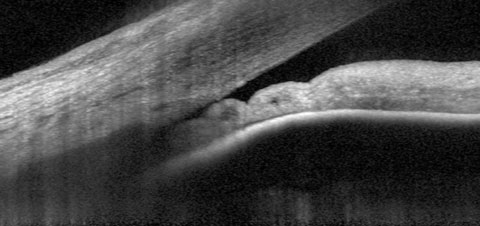 |
| AS-OCT in conjunction with other screenings would help detect a considerable amount of narrow angles and not incur much more cost. Photo: James L. Fanelli, OD. Click image to enlarge. |
Given gonioscopy’s inconveniences, such as needing a dark clinic room and using a somewhat challenging technique, researchers have put efforts into changing how angle closure glaucoma can be screened. One recent study selected individuals aged 60 or older from a door-to-door census in low-lying Nepal to undergo certain testing to detect for narrow angles.
The 12,633 people included underwent anterior segment OCT (AS-OCT), posterior segment OCT and intraocular pressure (IOP) testing. Referral was given to 697 patients meeting the referral criteria to have a comprehensive eye exam including gonioscopy, with 2,419 referred on other criteria. Referral criteria included the most extreme 2.5% of AS-OCT measurements as well as retinal OCT results suggesting cases of glaucomatous optic neuropathy, diabetic retinopathy, age-related macular degeneration and elevated IOP. Of those referred, 858 had gonioscopy performed by a glaucoma specialist.
All five AS-OCT parameters provided good diagnostic information on predicting eyes with gonioscopically narrow angles, but the one that provided the most information was angle opening distance at 750 µm from the scleral spur. This showed optimal sensitivity of 87% with 77% specificity at a cutpoint of 367µm and sensitivity of 65% when specificity was constrained to 90%.
Elaborating on their findings, the study authors highlight that about 70% of participants with abnormal AS-OCT results in both eyes had gonioscopically narrow angles compared with only 40% of those who had abnormal results in one eye. Also, consistent with previous study findings, they found that all mean AS-OCT parameter scores were higher in men and in older age groups. This might suggest that anterior chamber angle parameters may increase with age in this population, which is inconsistent with studies conducted in East Asia that have found reduced anterior chamber distance with age. However the reason for the disparity is unclear, but one explanation may be from differences in ocular anatomy by study population.
Also important is that this study echoes others that have found the parameter of scleral spur distance to be among the most important predictors of gonioscopically narrow angles. Similarly, optimal thresholds for classifying narrow angles were matched in range here as with prior reports.
The authors do note that their cutpoint of 90% specificity would result in a large fraction of false positive tests, given the low prevalence of narrow angles in the general population. However, this cutpoint detected only 65% of cases even under the best circumstances, which was lower than studies using deep learning. As such, they suggest that the level of sensitivity observed here may be too low to support widespread use of the AS-OCT thresholds in standalone screenings.
But when considering other options, “AS-OCT screening would almost certainly be done as an accompaniment to posterior segment OCT imaging. In this broader context, it may make sense to include AS-OCT in the overall package of screening examinations, since a considerable number of cases of narrow angles could be detected with minimal incremental cost.”
Although this is positive for patients and clinicians, the authors do still remind that “the clinical utility of diagnosing gonioscopically narrow angles remains unclear given previous studies that have shown that the majority of eyes with narrow angles do not progress to vision-threatening disease.”
Pradhan S, Sah RK, Bhandari G, et al. Anterior segment optical coherence tomography for detection of narrow angles: a community-based diagnostic accuracy study. Ophthalmol Glaucoma. August 20, 2023. [Epub ahead of print]. |

